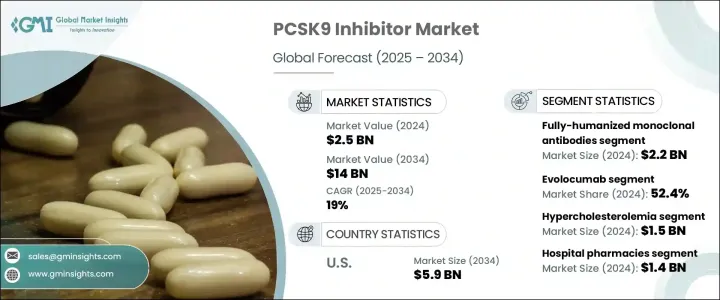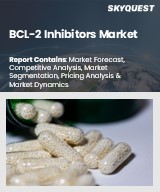
|
시장보고서
상품코드
1740898
PCSK9 억제제 시장 기회, 성장 촉진요인, 산업 동향 분석 및 예측(2025-2034년)PCSK9 Inhibitor Market Opportunity, Growth Drivers, Industry Trend Analysis, and Forecast 2025 - 2034 |
||||||
세계의 PCSK9 억제제 시장은 2024년에는 25억 달러로 평가되었으며 CAGR 19%를 나타내 2034년에는 140억 달러에 이를 것으로 추정됩니다.
이 눈부신 확대는 심혈관 질환의 세계 증가, 임상 실천의 진화, 환자 의식 증가로 인해 첨단 콜레스테롤 감소 요법에 대한 수요가 급증했다는 것을 반영합니다. 예방 헬스케어, 특히 지질 프로파일의 관리에 대한 관심 증가는 환자와 의료 제공업체 모두에게 더 효과적인 치료 옵션을 요구하도록 촉구하고 있습니다. 생활 습관병, 노화, 비만과 당뇨병 증가도 더 나은 콜레스테롤 관리 옵션의 필요성을 부추기고 있습니다. PCSK9 억제제는 특히 고위험 환자에서 전통적인 스타틴계 약제에서는 달성할 수 없었던 표적 접근법을 제공함으로써 큰 지지를 얻고 있습니다. 생물 제제의 끊임없는 기술 혁신, 유리한 상환 정책, 정밀의료에 대한 투자 유입은 치료 전망을 재구성하고 시장 기업이 세계적인 존재를 강화할 새로운 기회를 열고 있습니다.

PCSK9 억제제 영역의 현저한 성장은 주로 가족성 고콜레스테롤혈증 및 죽상동맥경화증과 같은 콜레스테롤 관련 질환의 유병률 증가에 의해 뒷받침되고 있습니다. 효과적인 치료법을 적극적으로 요구하게 되어 있습니다. 공중위생의 대처나 교육 캠페인은 콜레스테롤 컨트롤의 중요성에 스포트라이트를 맞추는데 큰 역할을 완수해, 치료에 대한 관심을 현저하게 높이고 있습니다. 입수가 용이한 것이 주요 원인입니다. 최신 임상 가이드라인으로 이어진 건강관리 전문가는 특히 심혈관 위험이 높은 환자에 대해 이러한 치료제를 보다 자주 처방하고 있습니다. 광범위한 접근성을 확보하고 시장 개척에 추가적인 탄력성을 부여하고 있습니다.
| 시장 범위 | |
|---|---|
| 시작 연도 | 2024년 |
| 예측 연도 | 2025-2034년 |
| 시작 금액 | 25억 달러 |
| 예측 금액 | 140억 달러 |
| CAGR | 19% |
2024년 PCSK9 억제제 시장에서 에볼로쿠맙 부문은 52.4%의 압도적인 점유율을 차지해 콜레스테롤 관리에 적합한 치료제로서의 지위를 재확인하였습니다. 프로바이더는 스타틴계 약제가 주효하지 않는 환자나 적극적인 지질 저하 전략이 필요한 환자에게 계속해서 에볼로쿠맙을 우선적으로 사용하고 있습니다.
완전 인간화 단일클론항체는 2024년에 22억 달러의 모달리티를 창출했습니다. 불량한 생산 과정의 진보는 치료의 안전성을 높이고, 가용성을 넓히고, 투여 간격의 연장을 가능하게 하고, 환자의 유지율을 향상시키고 있습니다.
미국의 PCSK9 억제제 시장은 2034년까지 59억 달러를 창출할 것으로 예측되고 있습니다. 위치하는 국가의 임상 가이드라인 업데이트로 처방률이 가속화되고 있습니다.
세계의 PCSK9 억제제 시장 주요 기업으로는 사노피, 리제넬론, 준시 바이오사이언시스, 암젠, 아케소 바이오파마, 노바티스, 이노벤트 등이 있습니다. 경쟁력을 강화하기 위해 각 회사는 생물 제제 파이프라인의 확충, 창약 가속을 위한 전략적 파트너십 형성, 실제 임상시험에 많은 투자를 실시했습니다.
목차
제1장 조사 방법과 범위
제2장 주요 요약
제3장 업계 인사이트
- 생태계 분석
- 업계에 미치는 영향요인
- 성장 촉진요인
- 심혈관질환(CVD)의 유병률 상승
- 치료법과 연구개발의 진보
- 유리한 상환 정책
- 업계의 잠재적 위험 및 과제
- 고액의 치료비
- 제네릭 스타틴과의 경쟁
- 성장 촉진요인
- 성장 가능성 분석
- 규제 상황
- 트럼프 정권에 의한 관세에 대한 영향
- 무역에 미치는 영향
- 무역량의 혼란
- 보복 조치
- 업계에 미치는 영향
- 공급측의 영향(원재료)
- 주요 원재료의 가격 변동
- 공급망 재구성
- 생산 비용에 미치는 영향
- 수요측의 영향(판매가격)
- 최종 시장에의 가격 전달
- 시장 점유율 동향
- 소비자의 반응 패턴
- 공급측의 영향(원재료)
- 영향을 받는 주요 기업
- 전략적인 업계 대응
- 공급망 재구성
- 가격 설정 및 제품 전략
- 정책관여
- 전망과 향후 검토 사항
- 무역에 미치는 영향
- 기술적 상황
- 향후 시장 동향
- 갭 분석
- 특허 분석
- Porter's Five Forces 분석
- PESTEL 분석
제4장 경쟁 구도
- 서론
- 기업의 시장 점유율 분석
- 기업 매트릭스 분석
- 주요 시장 기업의 경쟁 분석
- 경쟁 포지셔닝 매트릭스
- 전략 대시보드
제5장 시장 추계·예측 : 약제별(2021-2034년)
- 주요 동향
- 알리로쿠맙
- 에볼로쿠맙
- 인클리실란
- 기타 약물
제6장 시장 추계·예측 : 모달리티별(2021-2034년)
- 주요 동향
- 완전 인간화 단일클론항체
- siRNA
제7장 시장 추계·예측 : 적응증별(2021-2034년)
- 주요 동향
- 고지혈증
- 고콜레스테롤혈증
- 심혈관 질환
제8장 시장 추계·예측 : 유통 채널별(2021-2034년)
- 주요 동향
- 병원 약국
- 소매 약국
- 전자상거래
제9장 시장 추계·예측 : 지역별(2021-2034년)
- 주요 동향
- 북미
- 미국
- 캐나다
- 유럽
- 독일
- 영국
- 프랑스
- 스페인
- 이탈리아
- 네덜란드
- 아시아태평양
- 중국
- 일본
- 인도
- 호주
- 한국
- 라틴아메리카
- 브라질
- 멕시코
- 아르헨티나
- 중동 및 아프리카
- 남아프리카
- 사우디아라비아
- 아랍에미리트(UAE)
제10장 기업 프로파일
- Akeso Biopharma
- Amgen
- Innovent
- Junshi Biosciences
- Novartis
- Regeneron Pharmaceuticals
- Sanofi
The Global PCSK9 Inhibitor Market was valued at USD 2.5 billion in 2024 and is estimated to grow at a CAGR of 19% to reach USD 14 billion by 2034. This impressive expansion reflects a robust surge in the demand for advanced cholesterol-lowering therapies, driven by the global rise in cardiovascular diseases, evolving clinical practices, and heightened patient awareness. The increasing focus on preventive healthcare, particularly around managing lipid profiles, is pushing both patients and healthcare providers to seek more effective treatment alternatives. Lifestyle diseases, aging demographics, and an uptick in obesity and diabetes cases are also fueling the need for better cholesterol management options. PCSK9 inhibitors have gained significant traction for offering a targeted approach that traditional statins often fail to deliver, especially among high-risk patients. Continuous innovations in biologics, favorable reimbursement policies, and an influx of investment into precision medicine are reshaping the treatment landscape, opening new opportunities for market players to strengthen their global presence.

The notable growth in the PCSK9 inhibitor space is primarily fueled by the increasing prevalence of cholesterol-related disorders such as familial hypercholesterolemia and atherosclerosis. With growing awareness about the risks tied to elevated LDL cholesterol levels, more patients are actively seeking effective treatment options. Public health initiatives and educational campaigns have played a major role in spotlighting the importance of cholesterol control, significantly boosting treatment uptake. Patients now demonstrate better adherence to prescribed regimens, largely due to improved understanding and wider accessibility of PCSK9 inhibitors. Healthcare professionals, guided by updated clinical guidelines, are prescribing these therapies more frequently, especially for individuals facing high cardiovascular risks. Advanced reimbursement structures across developed regions, particularly in North America and Europe, are ensuring broader access to high-risk populations, adding further momentum to market growth. PCSK9 inhibitors work by blocking a specific protein that hinders the liver's ability to eliminate LDL cholesterol, helping achieve superior cholesterol reduction compared to traditional therapies.
| Market Scope | |
|---|---|
| Start Year | 2024 |
| Forecast Year | 2025-2034 |
| Start Value | $2.5 Billion |
| Forecast Value | $14 Billion |
| CAGR | 19% |
The evolocumab segment held a dominant 52.4% share in the PCSK9 inhibitor market in 2024, reaffirming its position as a preferred therapy for cholesterol management. With a strong clinical record of significantly reducing LDL cholesterol among high-risk patients, evolocumab remains the benchmark treatment. Healthcare providers continue to prioritize evolocumab for patients who either do not respond to statins or need aggressive lipid-lowering strategies. The surge in cardiovascular conditions, driven by aging populations and unhealthy lifestyles, is expected to further elevate the demand for reliable therapies like evolocumab, enhancing the segment growth outlook through the forecast period.
Fully humanized monoclonal antibodies generated USD 2.2 billion in 2024 within the modality segments. These biologics are meticulously engineered for high specificity, minimizing immune-related side effects while delivering powerful LDL-lowering outcomes. Advances in antibody technology and scalable production processes have enhanced therapeutic safety, broadened accessibility, and enabled extended dosing intervals, improving patient retention rates. As clinical data continues to show a reduction in major cardiovascular events, their integration into frontline treatment protocols is deepening steadily.
The U.S. PCSK9 inhibitor market is projected to generate USD 5.9 billion by 2034. This growth is anchored by the country's high cardiovascular disease burden, robust reimbursement environment, and strategic investments in precision healthcare. Updated national clinical guidelines that position PCSK9 inhibitors as first-line therapies have accelerated prescribing rates. Physician education campaigns and targeted patient outreach efforts are further solidifying the U.S.'s leadership in the global cholesterol management space.
Key players in the Global PCSK9 Inhibitor Market include Sanofi, Regeneron Pharmaceuticals, Junshi Biosciences, Amgen, Akeso Biopharma, Novartis, and Innovent. To strengthen their competitive edge, companies are expanding biologics pipelines, forming strategic partnerships for accelerated drug discovery, and investing heavily in real-world evidence studies. Collaborative efforts with healthcare systems, advancements in biosimilar development, and innovations in personalized dosing solutions are enhancing global reach and driving higher patient adherence.
Table of Contents
Chapter 1 Methodology and Scope
- 1.1 Market scope and definitions
- 1.2 Research design
- 1.2.1 Research approach
- 1.2.2 Data collection methods
- 1.3 Base estimates and calculations
- 1.3.1 Base year calculation
- 1.3.2 Key trends for market estimation
- 1.4 Forecast model
- 1.5 Primary research and validation
- 1.5.1 Primary sources
- 1.5.2 Data mining sources
Chapter 2 Executive Summary
- 2.1 Industry 3600 Synopsis
Chapter 3 Industry Insights
- 3.1 Industry ecosystem analysis
- 3.2 Industry impact forces
- 3.2.1 Growth drivers
- 3.2.1.1 Rising prevalence of cardiovascular diseases (CVDs)
- 3.2.1.2 Advancements in therapeutics and R&D
- 3.2.1.3 Favorable reimbursement policies
- 3.2.2 Industry pitfalls and challenges
- 3.2.2.1 High cost of treatment
- 3.2.2.2 Competition from generic statins
- 3.2.1 Growth drivers
- 3.3 Growth potential analysis
- 3.4 Regulatory landscape
- 3.5 Trump administration tariffs
- 3.5.1 Impact on trade
- 3.5.1.1 Trade volume disruptions
- 3.5.1.2 Retaliatory measures
- 3.5.2 Impact on the Industry
- 3.5.2.1 Supply-side impact (raw materials)
- 3.5.2.1.1 Price volatility in key materials
- 3.5.2.1.2 Supply chain restructuring
- 3.5.2.1.3 Production cost implications
- 3.5.2.2 Demand-side impact (selling price)
- 3.5.2.2.1 Price transmission to end markets
- 3.5.2.2.2 Market share dynamics
- 3.5.2.2.3 Consumer response patterns
- 3.5.2.1 Supply-side impact (raw materials)
- 3.5.3 Key companies impacted
- 3.5.4 Strategic industry responses
- 3.5.4.1 Supply chain reconfiguration
- 3.5.4.2 Pricing and product strategies
- 3.5.4.3 Policy engagement
- 3.5.5 Outlook and future considerations
- 3.5.1 Impact on trade
- 3.6 Technological landscape
- 3.7 Future market trends
- 3.8 Gap analysis
- 3.9 Patent analysis
- 3.10 Porter's analysis
- 3.11 PESTEL analysis
Chapter 4 Competitive Landscape, 2024
- 4.1 Introduction
- 4.2 Company market share analysis
- 4.3 Company matrix analysis
- 4.4 Competitive analysis of major market players
- 4.5 Competitive positioning matrix
- 4.6 Strategy dashboard
Chapter 5 Market Estimates and Forecast, By Drug, 2021 - 2034 ($ Mn)
- 5.1 Key trends
- 5.2 Alirocumab
- 5.3 Evolocumab
- 5.4 Inclisiran
- 5.5 Other drugs
Chapter 6 Market Estimates and Forecast, By Modality, 2021 - 2034 ($ Mn)
- 6.1 Key trends
- 6.2 Fully-humanized monoclonal antibodies
- 6.3 siRNA
Chapter 7 Market Estimates and Forecast, By Indication, 2021 - 2034 ($ Mn)
- 7.1 Key trends
- 7.2 Hyperlipidemia
- 7.3 Hypercholesterolemia
- 7.4 Cardiovascular diseases
Chapter 8 Market Estimates and Forecast, By Distribution Channel, 2021 - 2034 ($ Mn)
- 8.1 Key trends
- 8.2 Hospital pharmacies
- 8.3 Retail pharmacies
- 8.4 E-commerce
Chapter 9 Market Estimates and Forecast, By Region, 2021 - 2034 ($ Mn)
- 9.1 Key trends
- 9.2 North America
- 9.2.1 U.S.
- 9.2.2 Canada
- 9.3 Europe
- 9.3.1 Germany
- 9.3.2 UK
- 9.3.3 France
- 9.3.4 Spain
- 9.3.5 Italy
- 9.3.6 Netherlands
- 9.4 Asia Pacific
- 9.4.1 China
- 9.4.2 Japan
- 9.4.3 India
- 9.4.4 Australia
- 9.4.5 South Korea
- 9.5 Latin America
- 9.5.1 Brazil
- 9.5.2 Mexico
- 9.5.3 Argentina
- 9.6 Middle East and Africa
- 9.6.1 South Africa
- 9.6.2 Saudi Arabia
- 9.6.3 UAE
Chapter 10 Company Profiles
- 10.1 Akeso Biopharma
- 10.2 Amgen
- 10.3 Innovent
- 10.4 Junshi Biosciences
- 10.5 Novartis
- 10.6 Regeneron Pharmaceuticals
- 10.7 Sanofi



















